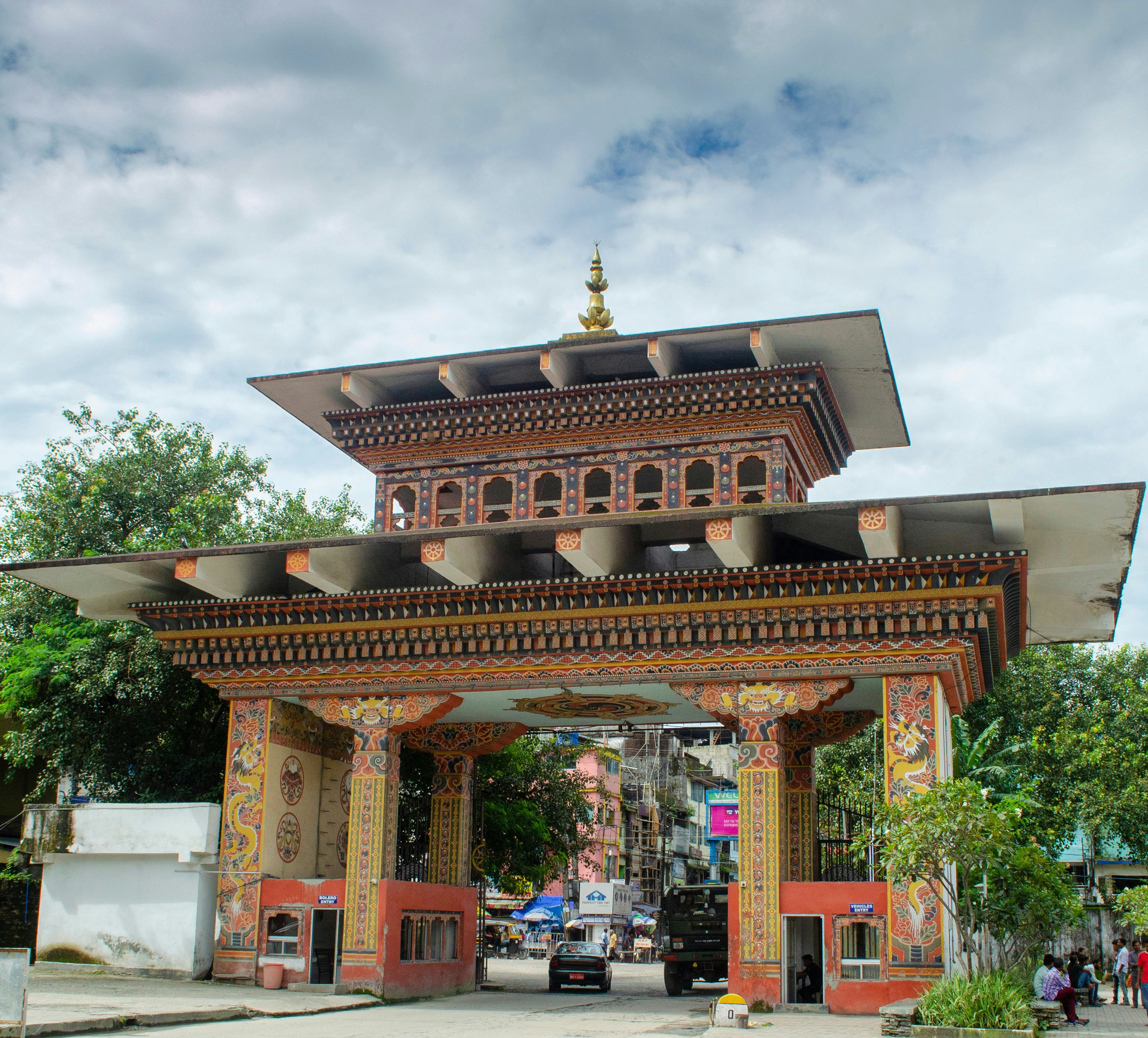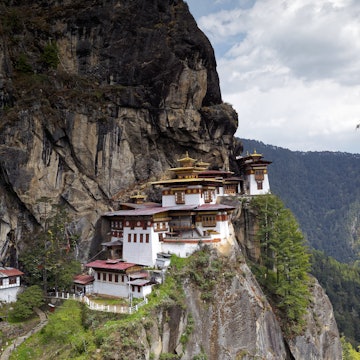

These top tips along with a guide to daily costs can help you plan your budget for a visit to Bhutan © skaman306 / Getty Images
Bhutan’s unofficial label as a modern-day Shangri La remains its biggest pull.
It’s full of details that are stranger than fiction: the only country in the world without traffic lights, with a national dish that hosts chili as the main ingredient (not a mere addition), and where Lama Drukpa Kunley, the 15th-century mystic lovingly known by the Bhutanese as the "divine madman" upholds the phallus as a protector against evil.
Despite being an expensive destination, with some careful planning it's possible to have many of Bhutan's top experiences while keeping your costs down. Here's how.

Daily costs
The first financial bullet to bite is Bhutan’s daily charge, which was recently halved to US$100. Also known as a "sustainable development fee", the reduced cost no longer covers accommodation or transport, but conversely, it gives you the flexibility to design your itinerary as per your budget.
Basic room for two: Nu 3500–4000
Farm stays: Nu 2500
Public transport: A shared taxi between cities costs about Nu 1500 per person, and a bus seat will cost about a third of that. A full taxi hire for sightseeing or travel averages around Nu 3500 for up to 100km (62 miles).
Tea/coffee: Nu 80–150
Sandwich: Nu 300
Dinner for two: Nu 1200
Beer/pint at the bar: Nu 250
Average daily cost: Nu 8000–10,000
1. Start your trip to Bhutan regionally
There are no direct flights to Bhutan from the global West. Most flights will have a stopover in neighboring India, so it’s wise to plan ahead and book separate tickets – first to India, and then onwards to Bhutan. Drukair is Bhutan’s national airline, and it has plenty of connections to New Delhi and Kolkata.
Either way, you’ll have to change planes, and if the tickets are done separately, it can save you up to a solid US$500. If you are not pressed for time (and have an Indian visa too), you can also squeeze in a short stopover to explore Delhi or the Golden Triangle, and really get your money’s worth.
That said, the cheapest flights into Bhutan are from Kathmandu, Nepal. Plus, you'll fly directly over Mount Everest – making it the most scenic route too.

2. Enter Bhutan by road
Tickets for the national carrier Drukair are on the higher end, but flying into Bhutan is not the only way to get there. Visitors up for slow travel can take a train/cab ride to Bhutan from Kolkata in India, via Hasimara and Phuentsholing.
New Jalpaiguri in India is the best-connected big train station to Phuentsholing. From the Indian capital, it takes over 20 hours by train at a minimal cost of around INR 2500 (US$30) for a premium seat (AC sleeper berth). Alternatively, you could fly to Bagdogra to beat the clock. The cost of the taxi and the time taken to Phuentsholing is nearly the same from both the train station and the airport – around INR 5000 (US$60) for around four hours of travel.
Bonus: The Phuentsholing immigration terminal is staffed through the week now (previously, you'd have to wait until Monday to clear immigration if you got in on the weekend), so you've got that much more flexibility on dates.
3. Know the rules well to avoid Bhutan-specific fines
Bhutan imposes heavy fines for breaking its strict policies that include no honking in certain zones and tobacco consumption outside designated zones, that can cost anything upwards of Nu 5000, along with a license suspension. Ensure that you follow the rules to avoid a plump setback to your wallet.
4. Time your visit right for cheaper options
Like most popular destinations, it's cheaper to visit Bhutan in the shoulder season, with unfavorable weather usually being the downside. Bhutan has two major travel seasons – spring and autumn – but a trip there during winter can still be rewarding for budget visitors. The valleys of Thimphu, Paro and Punakha that form the main cultural triangle of Bhutan are at elevations low enough to see little to no snow in the winter (February is comfortable with woollens, at around 10–12°C/50–54°F), so if you stick to it, you will, at best, be cold in the evenings (around -4°C/25°F) but have the option of retiring to your room. Climate change across the Himalayas has now shifted up the rhododendron bloom, so other than hotel discounts, you could also catch nature’s scarlet show as early as February.
The offseason period between June and August, when monsoons hit the country, is even cheaper. If you don't care about trekking or camping (leech alert!), you are in for some great deals – expect to pay about 20% less on air travel and accommodations.
5. Travel in greater numbers to share guide costs
Conveyance costs in Bhutan could be a deal breaker for solo travelers, especially since public transport systems in this part of the world are not as smooth as a mirror. There will surely be a cheap bus alternative available but it will cost you more in terms of time and effort, so it is best to share a taxi with a travel partner or two. Traveling with more people will also help you split the cost of the guide, which continues to be compulsory for foreigners and is upwards of Nu 2000 per day.

6. Check the festival calendar
Instead of paying specifically to attend a cultural show or have a paid one organized at your hotel, try to match your timing with an ongoing festival. Not only are many of these free to attend, but they're also bigger and better. Devotees, masked dancers, little children in their gho (traditional robes), and curious tourists all descend on the demarcated sites for pageants straight out of a fantasy. Pick any of the larger tschechus, or masked dance festivals, and if you luck out you may just get a rare glimpse of Bhutan's very poised king in attendance.
Note that festivals in Bhutan follow the lunar calendar; check dates before booking your trip and ideally cross-check them with your guide.
7. Opt for guesthouses over high-end accommodations
Unless you are staying at a five-star hotel in Bhutan, there isn’t a dramatic difference in other categories in hotels. Guesthouses are clean and comfortable with decent bathrooms, and housed in beautiful buildings that adhere to the traditional architecture as the state demands.
If you are able and willing to climb stairs, ask for a room on the top floor; they have slightly lower ceilings because of the roof design making them smaller (but also complete with the cozy attic vibe). Since the older buildings do not come with lifts, these rooms usually go for a lower price. Farm stays in city outskirts are also becoming increasingly popular as great value-for-money options. Plus your money will be going directly to local people instead of a hotel chain.
8. Eat local dishes
Eating out in Bhutan is not crazy expensive, so if you can toughen up for local foods, you will emerge a winner. Ema datse, Bhutan’s much talked about national dish, uses whole chilies dunked in cheese stew, and is surprisingly not the fire-fest it sounds like. Paired with rice, it is hugely popular and a lunch staple available at most local restaurants, including highway stopovers, at very reasonable prices. If the chilies scare you, leave them aside and have the rice with the mildly spicy cheese gravy. Pork with fried rice, noodles, dumplings and other mainstream dishes can also make for an affordable but satisfying meal.
9. Buy from the source
Whether it’s groceries or local handicrafts, you’re better off buying directly from the source. Bhutan has several traditional art schools where not only can you watch artists at work and get an insight into the form and training, but also buy directly from them instead of purchasing the same at a hiked price from a souvenir store. A traditional handmade mask will cost you anywhere from Nu 2000 to Nu 8000 at the source, but will be sold at a high-end store for Nu 10,000 to Nu 15,000.
10. Camp on the hiking trails
The cultural monuments and intangible heritage of Bhutan are its undisputed draw, but its great outdoors is something else too. The recently reintroduced Trans Bhutan trail may be deemed as one of the greatest Himalayan walks, but it is also an expensive trail starting from the less accessible eastern end of the country.
Fortunately Bhutan has some other shorter and wildly beautiful trails, where the lower cost of camping can help balance your hotel stays and eating out, with the added bonus of a hiking experience thrown in. Factor in a per day cost of at least US$200 all-inclusive for treks.














